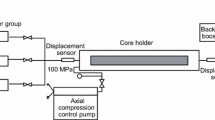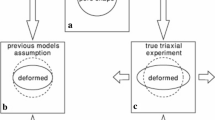Abstract
To study the compaction law and overpressure evolution in deepwater shallow sediments, a large-strain compaction model that considers material nonlinearity and moving boundary is formulated. The model considers the dependence of permeability and material properties on void ratio. The modified Cam-Clay model is selected as the constitutive relations of the sediments, and the deactivation/reactivation method is used to capture the moving top surface during the deposition process. A one-dimensional model is used to study the compaction law of the shallow sediments. Results show that the settlement of the shallow sediments is large under their own weight during compaction. The void ratio decreases strictly with burial depth and decreases more quickly near the seafloor than in the deeper layers. The generation of abnormal pressure in the shallow flow sands is closely related to the compaction law of shallow sediments. The two main factors that affect the generation of overpressure in the sands are deposition rate and permeability of overlying clay sediments. Overpressure increases with an increase in deposition rate and a decrease in the permeability of the overlying clay sediment. Moreover, an upper limit for the overpressure exists. A two-dimensional model is used to study the differential compaction of the shallow sediments. The pore pressure will still increase due to the inflow of the pore fluid from the neighboring clay sediment even though the deposition process is interrupted.
Similar content being viewed by others
References
Athy, L. F., 1930. Density, porosity, and compaction of sedimentary rocks. AAPG Bulletin, 14 (1): 1–24.
Audet, D. M., and Fowler, A. C., 1992. A mathematical model for compaction in sedimentary basins. Geophysical Journal International, 110 (3): 577–590.
Bachrach, R., 2016. Mechanical compaction in heterogeneous clastic formations from plastic-poroelastic deformation principles: Theory and applications. Geophysical Prospecting, 65: 724–735.
Bernaud, D., Dormieux, L., and Maghous, S., 2006. A constitutive and numerical model for mechanical compaction in sedimentary basins. Computers and Geotechnics, 33 (6): 316–329.
Biot, M. A., 1941. General theory of three-dimensional consolidation. Journal of Applied Physics, 12 (2): 155–164.
Carter, J. P., Small, J. C., and Booker, J. R., 1977. A theory of finite elastic consolidation. International Journal of Solids and Structures, 13 (5): 467–478.
Chopra, M. B., and Dargush, G. F., 1992. Finite-element analysis of time-dependent large-deformation problems. International Journal for Numerical and Analytical Methods in Geomechanics, 16 (2): 101–130.
Davis, E. H., and Raymond, G. P., 1965. A non-linear theory of consolidation. Geotechnique, 15 (2): 161–173.
Detournay, E., and Cheng, A. H. D., 1993. Fundamentals of poroelasticity. In: Comprehensive Rock Engineering: Principles, Practice & Projects. Pergamon Press, Oxford, 90–95.
Fowler, A. C., and Yang, X. S., 1998. Fast and slow compaction in sedimentary basins. SIAM Journal on Applied Mathematics, 59 (1): 365–385.
Gherasim, M., Viceer, S., Brusova, O., and Naumenko, J., 2015. Application of an integrated workflow for shallow-hazard characterization using a 3D high-resolution survey offshore Azerbaijan. The Leading Edge, 34 (4): 390–396.
Gibson, R. E., 1958. The progress of consolidation in a clay layer increasing in thickness with time. Geotechnique, 8 (4): 171–182.
Gibson, R. E., England, G. L., and Hussey, M. J. L., 1967. The Theory of one-dimensional consolidation of saturated clays: 1. finite non-Linear consildation of thin homogeneous layers. Geotechnique, 17 (3): 261–273.
Haneberg, W. C., Kelly, J. T., Graves, H. L., and Dan, G., 2015. A GIS-based decision-support approach to deepwater drilling-hazard maps. The Leading Edge, 34 (4): 398–404.
Hedberg, H. D., 1936. Gravitational compaction of clays and shales. American Journal of Science, 5 (31): 241–287.
Kikinzon, E., Kuznetsov, Y., Maliassov, S., and Sumant, P., 2015. Modeling fluid flow and compaction in sedimentary basins using mixed finite elements. Computational Geosciences, 19 (2): 285–298.
Mallick, S., and Dutta, N. C., 2002. Shallow water flow prediction using prestack waveform inversion of conventional 3D seismic data and rock modeling. The Leading Edge, 21 (7): 675–680.
Nygård, R., Gutierrez, M., Gautam, R., and Hoeg, K., 2004. Compaction behavior of argillaceous sediments as function of diagenesis. Marine and Petroleum Geology, 21 (3): 349–362.
O’Leary, J., Flores, J. C., Rubinstein, P., and Garrison, G., 2004. Cementing deepwater, low-temperature Gulf of Mexico formations prone to shallow flows. IADC/SPE Drilling Conference. Dallas, USA, 1–11.
Skogdalen, J. E., Utne, I. B., and Vinnem, J. E., 2011. Developing safety indicators for preventing offshore oil and gas deepwater drilling blowouts. Safety Science, 49 (8): 1187–1199.
Sun, B. J., and Zhang, Z. N., 2015. Challenges and Countermeasures for the drilling and completion of deepwater wells in the South China Sea. Petroleum Drilling Techniques, 43 (4): 1–7 (in Chinese with English abstract).
Sun, J., Deng, J., Yu, B. H., and Peng, C. Y., 2015. Model for fracture initiation and propagation pressure calculation in poorly consolidated sandstone during waterflooding. Journal of Natural Gas Science and Engineering, 22: 279–291.
Sun, Y., Zhao, T., and Qin, K., 2014. Numerical simulation of overpressure of shallow water flow in Baiyun Sag of the northern South China Sea. Advances in Earth Science, 29 (9): 1055–1064 (in Chinese with English abstract).
Xie, K. H., and Leo, C. J., 2004. Analytical solutions of onedimensional large strain consolidation of saturated and homogeneous clays. Computers and Geotechnics, 31 (4): 301–314.
Xie, X. Y., Huang, J. Q., Wang, W. J., and Lin, J. Z., 2014. Influence of weight of soils on nonlinear finite strain consolidation for Ningbo soft clay. Journal of Zhejiang University (Engineering Science Edition), 48 (5): 827–834 (in Chinese with English abstract).
Xie, Y. H., 2014. A major breakthrough in deepwater natural gas exploration in a self-run oil/gas field in the northern South China Sea and its enlightenment. Natural Gas Industry, 34 (10): 1–8 (in Chinese with English abstract).
Acknowledgement
This study was funded by the National Key Basic Research Program of China (973 Program) (No. 2015 CB25 1201), NSFC-Shandong Joint Fund for Marine Science Research Centers (No. U1606401), and Key Science & Technology Foundation of Sanya (Nos. 2017PT13 and 2017PT14).
Author information
Authors and Affiliations
Corresponding author
Rights and permissions
About this article
Cite this article
Sun, J., Wu, S., Deng, J. et al. Numerical simulation of mechanical compaction of deepwater shallow sediments. J. Ocean Univ. China 17, 53–64 (2018). https://doi.org/10.1007/s11802-018-3461-6
Received:
Revised:
Accepted:
Published:
Issue Date:
DOI: https://doi.org/10.1007/s11802-018-3461-6




